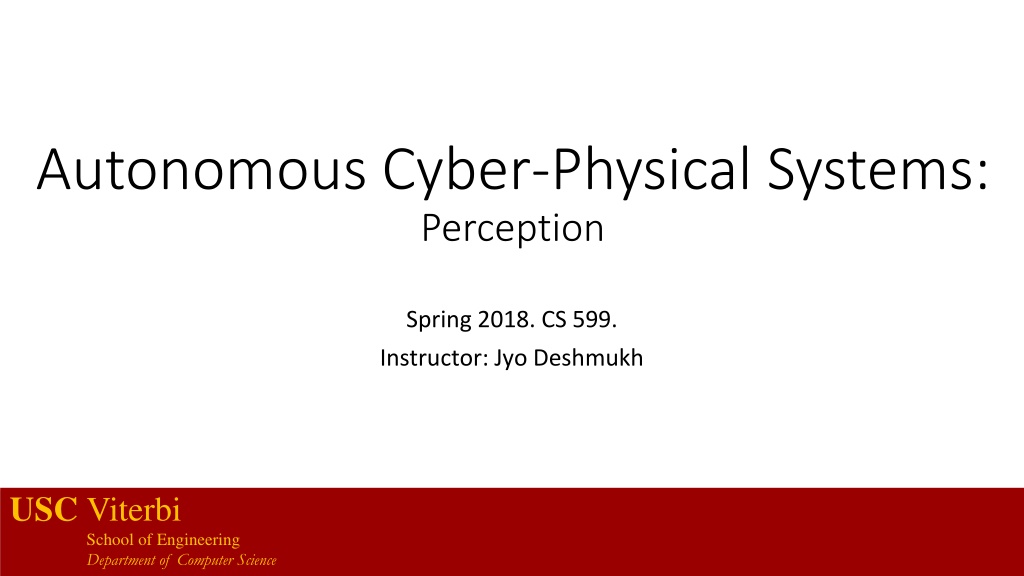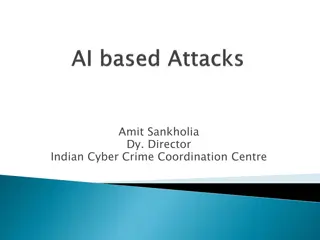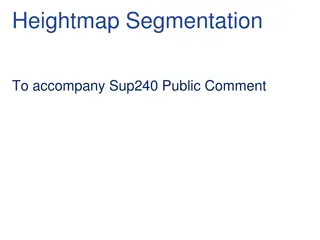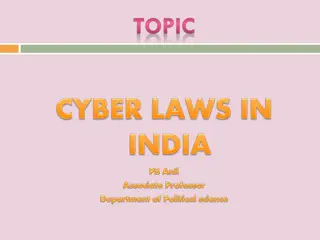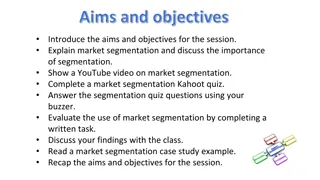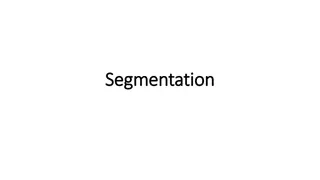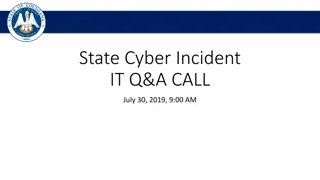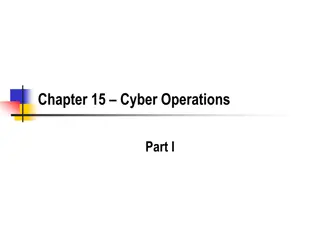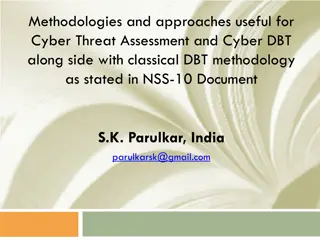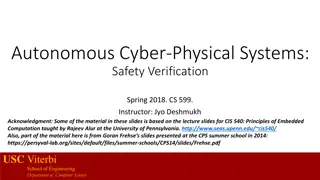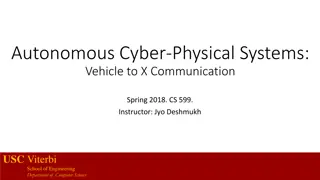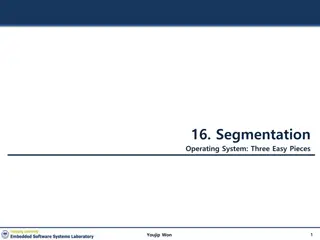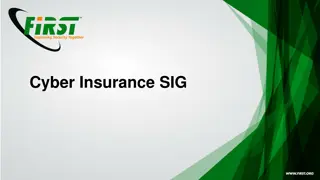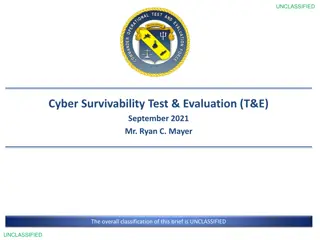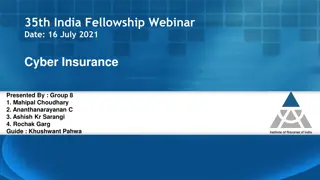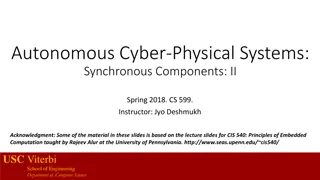Understanding Perception and Segmentation in Autonomous Cyber-Physical Systems
Delve into the realm of perception and segmentation in autonomous cyber-physical systems, exploring LiDAR and vision data representation, segmentation algorithms, and popular approaches for data representation. Discover how segmentation algorithms cluster points into groups using edge-based, region-based, model-based, attribute-based, graph-based, and deep-learning methods.
Download Presentation

Please find below an Image/Link to download the presentation.
The content on the website is provided AS IS for your information and personal use only. It may not be sold, licensed, or shared on other websites without obtaining consent from the author. Download presentation by click this link. If you encounter any issues during the download, it is possible that the publisher has removed the file from their server.
E N D
Presentation Transcript
Autonomous Cyber-Physical Systems: Perception Spring 2018. CS 599. Instructor: Jyo Deshmukh USC Viterbi School of Engineering Department of Computer Science
Overview Perception from LiDAR & Vision Localization USC Viterbi School of Engineering Department of Computer Science 2
Perception from LIDAR and vision Data representation Segmentation algorithms from LIDAR data Object Detection from camera data USC Viterbi School of Engineering Department of Computer Science 3
Data representation Following representations for LIDAR data are most popular: Point-cloud representation in the 3D space Feature representation Representation using grids The choice of representation guides the choice of the algorithms chosen downstream for segmentation/detection Point-cloud based approaches may need filtering algorithms to reduce number of points Voxel-grid filtering : cover the space with tiny boxes, and replace each box with the centroid of the box USC Viterbi School of Engineering Department of Computer Science 4
Data representation Feature-based approaches Extract specific features from the point cloud such as lines or surfaces Most memory-efficient approach, but accuracy subject to nature of the point cloud Grid-based approaches Discretize space into small grids and represent the point cloud as a spatial data structure Discretization-delta is a heuristic choice, and efficacy depends on the chosen delta USC Viterbi School of Engineering Department of Computer Science 5
Segmentation algorithms Segmentation: Clustering points into multiple homogenous groups Broadly divided into: Edge-based methods: Good when objects have strong artificial edge features (e.g. road curbs) Region-based methods: Based on region-growing, i.e. pick seed points, and then grow regions based on criteria such as Euclidean distance between points, surface normals etc. Model-based methods: Fit points into pre-defined categories such as planes, spheres, cones etc. Attribute-based methods: first compute attributes for each point, and then cluster based on attributes Graph-based methods: Cast point cloud into graph-based structures Deep-learning based methods USC Viterbi School of Engineering Department of Computer Science 6
Some popular segmentation algorithms RANSAC (random sample and consensus) Hough Transform Conditional Random Fields, Markov Random Fields (also used for sensor fusion between LIDAR and vision) USC Viterbi School of Engineering Department of Computer Science 7
RANSAC Algorithm for robust fitting of a model in the presence of outliers Given a fitting problem with parameters ?, estimate optimal values for ? What is a model ? Line, bounding box, etc., i.e. any parametric shape Assumptions: Parameters can be estimated from ? points There is a total of ? points Probability that a selected point is an inlier: ?? Probability that an iteration of RANSAC fails without finding a good fit: ????? USC Viterbi School of Engineering Department of Computer Science 8
RANSAC continued 1. Select ? points at random 2. Estimate ? values for the shape fitted to the above ? points (say the values is ? , and the resultant shape is now ?(? ) 3. Find how many of the ? points are within some ? tolerance of ? ? . Say this is ? 4. If ? is large enough, accept model and exit with success 5. Repeat 1 to 4 some times 6. Fail if you get here Hard part: how to choose ?, ,? USC Viterbi School of Engineering Department of Computer Science 9
Choosing parameters for RANSAC Pick ? based on how many points required to find a good fit for the shape Pick ? based on intuitively how many points would lie in a shape If there are multiple models or structures with an image, remove the points associated with a shape once RANSAC terminates with success, and then redo RANSAC log ????? log 1 ?? Pick = ? USC Viterbi School of Engineering Department of Computer Science 10
Hough Transform A tool to detect lines, circles and more general shapes One of the tools used for lane marking detection from (pre-processed) images Operates on sets of points and helps obtain a geometric representation of shapes that points may form We will see how Hough transform works in 2D USC Viterbi School of Engineering Department of Computer Science 11
HT basics ? (?1,?1) Map each point in the (?,?) space to a curve in ?,? (?2,?2) This transformation allows points to vote on which lines best represent them ? ? (?3,?3) Before understanding the normal form, let s look at a simple transformation: map ?,? space to the (?,?) space ? 3 2 ? 1 Each point thus maps to a line in the (?,?) space If lines corresponding to different points intersect: this represents a collection of collinear points with the slope and intercept defined by the intersection ? USC Viterbi School of Engineering Department of Computer Science 12
HT in polar coordinates Problem with the ?,? space is that ? for vertical lines. So all lines in the (?,?) space corresponding to points on a vertical line would only intersect at infinity. Resolved by instead considering the ?,? space Line in ?,? -space: ? = ?1cos? + ?1sin? Here, ? = length of normal to line, ? angle made by normal with ?-axis Now point in (?,?) space maps to a sinusoid in ?,? - space To find lines, we let the sinusoids vote: i.e. identify the points in a suitable grid that accumulate weight ? ? USC Viterbi School of Engineering Department of Computer Science 13
HT discussion Pros: Conceptually simple and easy to implement Robust to noise Handles missing and occluded data gracefully Can be adapted to various shapes beyond lines Cons: Computationally complex if there are many shapes to look for Can be fooled by apparent lines Collinear line segments may be hard to separate USC Viterbi School of Engineering Department of Computer Science 14
Graph-based algorithms for segmentation Random field: a family of random variables {?1, ,??} defined on some set ? (think of ? as the set of integers) that take values ?1, ,?? in some label set ? Markov Random field: ? ?? > 0 ?? ? ??? {?}) = ?? ? ??(?? ?? ?? is the neighborhood of node ? Conditional Random field: a MRF globally conditioned on another random field ? USC Viterbi School of Engineering Department of Computer Science 15
Gibbs distributions and cliques A set of sites (think about them as pixels or superpixels) ?1, ,?? form a clique if for a all ?,?, ?? ?(?) Gibbs distribution is a distribution of the following form: ? ? =1 ?? ? ? ? Here, ? ? is called the energy function of the form ? ? ??? , where ? is the set of all cliques, ? is a given clique, ?? is the clique potential independently defined for each clique. ? is a scalar called temperature, and ? is a normalizing factor to make sum of probabilities to 1. (Potential functions are like kernels). The probability distribution of any MRF can be written as a Gibbs distribution To find optimal segmentation of a point cloud, we try to find a labeling that minimizes the energy function exact problem is NP-hard, but efficient approximations exist. USC Viterbi School of Engineering Department of Computer Science 16
Detection algorithms for video data Detection of segmented clusters from LIDAR data is done using traditional machine learning algorithms based on SVMs, Gaussian Mixture Models etc. More interesting problem is detection from images Lane line marking detection Drivable path detection On-road object detection USC Viterbi School of Engineering Department of Computer Science 17
Image pre-processing Typically first step before applying detection algorithms Remove obstacles (e.g. other vehicles) Weaken shadows Normalize images by controlling camera exposure Limiting region of interest USC Viterbi School of Engineering Department of Computer Science 18
Lane marking detection Oldest application of vision in advanced driver-assist systems (ADAS) and critical in the self-driving space Used as feedback to vehicle control systems (Lane Departure Warning, Lane-Keep Assist, and Lane-Tracking Control) Several decades of work, but still not fully solved because of uncertainties in traffic conditions, and road-specific issues such as shadows, worn-out markings, directional arrows, warning text, pedestrian zebra crossings etc. Four/Five common steps: Lane line feature extraction Fitting pixels into various models (lines, parabolas, hyperbolas) Estimating vehicle pose based on fitted model (optional fourth step: use of temporal continuity) Image to world coordinates transformation USC Viterbi School of Engineering Department of Computer Science 19
Model fitting and Pose estimation Simple case: lane lines are straight lines (straight highway segments) More complicated case: curvy roads, lane markings may have to be fit with splines, contours etc. Pose estimation is typically done using Kalman filter or particle filter (typically more reliable) Requires inverse perspective transformation to go from lane coordinates to world coordinates Lane-level localization involves estimating vehicle lateral position and moving orientation (again can use vehicle odometry + Kalman filter) USC Viterbi School of Engineering Department of Computer Science 20
Lane line extraction Based on lane markings having large contrast with road pavement Edge detectors followed by Hough Transform to get the complete lane Basic idea in edge detection: Edges are discontinuities of intensity in images, correspond to local maxima of the image gradient Na ve image gradients can be affected by noise in the image, so solution is to take smooth derivatives i.e. first smooth an image by convolving it with a Gaussian filter, and then take the derivative Edges correspond to zero-crossings of the second derivative of the Gaussian or LOG (Laplacian of the Gaussian) Approach used in Canny edge detector (OpenCV) and Matlab Matlab first transforms image from front-facing view to bird s eye view and uses a vertically oriented Gaussian filter USC Viterbi School of Engineering Department of Computer Science 21
Drivable-path detection Detecting road boundaries where vehicle can drive freely and legally without collisions Several image-processing based algorithms using feature detection or feature learning : generally deemed to be not robust enough for erratic driving conditions Deep learning provides the most popular set of techniques based on CNNs (we will look at these in the next lecture) Other algorithms include exploiting GPS data and OpenStreetMap data USC Viterbi School of Engineering Department of Computer Science 22
On-road object detection Detect other vehicles, pedestrians, bicycles etc. Again, deep learning based methods seem to be clear winners General pipeline for deep learning approaches: Set of proposal bounding boxes generated in the input image Each proposal box is passed through a CNN to obtain a label and fine tune the bounding boxes We will look at this in some detail in the next lecture USC Viterbi School of Engineering Department of Computer Science 23
Localization Most common approach is to use vehicle odometry + GPS + Kalman filter This becomes unreliable in urban environments, tunnels, tall buildings etc. where GPS signal quality is poor Map-aided localization: Use local features to achieve precise localization SLAM (simultaneous localization and mapping): most popular approach USC Viterbi School of Engineering Department of Computer Science 24
Main steps in SLAM Car moves reaching a new point of view of its location Motion model captures car motion, but could be inaccurate because of actuation errors Car discovers interesting features in the environment that need to be incorporated into the map Features are called landmarks; because of sensor errors positions of landmarks will be uncertain. Mathematical model to determine position of landmarks from observation is called inverse observation model USC Viterbi School of Engineering Department of Computer Science 25
Main steps in SLAM (continued) Car observes previously mapped landmarks and uses them to correct its self-localization and positions of landmarks in the map Localization and landmark uncertainties decrease, and model the predict values of measurement from predicted landmark location and robot localization is called direct observation model SLAM = above three models + an estimator (Extended Kalman Filter is common) Another perspective on SLAM is view it as a Bayesian filtering problem USC Viterbi School of Engineering Department of Computer Science 26
SLAM as Bayesian filtering Estimate joint posterior probability ? ?1:?,? ?1:?,?1,? 1) about the map ? and the trajectory ?1:? given sensor measurements ?1:? and the control inputs ?1:? 1 Solutions are based on EKF and Particle Filter Rao-Blackwellized Particle Filters (RBPF) is a particle filter approach which allows vehicle trajectory to be computed first and then the map to be constructed. Basically it treats the vehicle as a particle and allows above probability to be expressed as follows: ? ?1:?,? ?1:?,?1,? 1) = ? ? ?1:?,?1:?) ? ?1:??1:?,?1,? 1) Marginalization of probabilities allows RBPF to be used in algorithms like FAST-SLAM USC Viterbi School of Engineering Department of Computer Science 27
Bibliography The flow of the material in this lecture is almost entirely based on the following paper: Pendleton, Scott Drew, Hans Andersen, Xinxin Du, Xiaotong Shen, Malika Meghjani, You Hong Eng, Daniela Rus, and Marcelo H. Ang. "Perception, planning, control, and coordination for autonomous vehicles." Machines 5, no. 1 (2017): 6. Good introduction to Hough transform and various vision algorithms: http://aishack.in/tutorials/hough- transform-normal/ Hough transform basics: http://web.ipac.caltech.edu/staff/fmasci/home/astro_refs/HoughTrans_review.pdf Graph-based clustering: http://vision.stanford.edu/teaching/cs231b_spring1213/slides/segmentation.pdf MRF/CRF fundamentals https://www.cs.umd.edu/~djacobs/CMSC828seg/MRFCRF.pdf Edge detection: https://www.swarthmore.edu/NatSci/mzucker1/e27_s2016/filter-slides.pdf SLAM: https://people.eecs.berkeley.edu/~pabbeel/cs287-fa09/readings/Durrant-Whyte_Bailey_SLAM- tutorial-I.pdf 1. 2. 3. 4. 5. 6. 7. USC Viterbi School of Engineering Department of Computer Science 28
